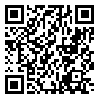Volume 2, Issue 1 (2014)
Health Educ Health Promot 2014, 2(1): 17-26 |
Back to browse issues page
Download citation:
BibTeX | RIS | EndNote | Medlars | ProCite | Reference Manager | RefWorks
Send citation to:



BibTeX | RIS | EndNote | Medlars | ProCite | Reference Manager | RefWorks
Send citation to:
Dezham S, Roozbahani N, Khorsandi M. The Most Critical Barriers in Conducting Mammography Screening among the Iranian Women in Arak in 2014. Health Educ Health Promot 2014; 2 (1) :17-26
URL: http://hehp.modares.ac.ir/article-5-7400-en.html
URL: http://hehp.modares.ac.ir/article-5-7400-en.html
1- M.Sc. Student, Department of Health Education, Faculty of Health, Arak University of Medical Sciences , Arak, Iran
2- Assistant Professor, Department of Health Education, Faculty of Health, Arak University of Medical Science , Arak, Iran
3- Associate Professor, Department of Health Education, Faculty of Health, Arak University of Medical Science , Arak, Iran
2- Assistant Professor, Department of Health Education, Faculty of Health, Arak University of Medical Science , Arak, Iran
3- Associate Professor, Department of Health Education, Faculty of Health, Arak University of Medical Science , Arak, Iran
Abstract: (5241 Views)
Aim: Regarding the high prevalence of breast cancer among the Iranian women and lack of attention to mammography screening, planning the behavior promotion interventions would be practicable through determining the barriers of conducting mammography screening behavior. The purpose of this study was determining the barriers of conducting breast cancer mammography screening among the women over 40 years. Methods: The participants of this crass-sectional study consisted of 294 over 40-years old women in Arak-Iran who completed the questionnaire of mammography barriers. The questionnaire used was based on Champion's revised Health Belief Model Scale (CHBMS). Sampling was based on the population. All hygiene officers of the Health and Cure Centers of Arak were asked to randomly select some samples among the women over 40 years. In this way, all the city's areas were covered. Inclusion criteria were women over 40 years, not already suffering from breast cancer, or having a family member (mother or sister) affected by the disease. Findings: The findings revealed that the high cost is the main barrier (20.1%) of mammography screening among the population. Among the other reasons, one may point to fear of discovering a cancer mass (9.5%), painful procedures of mammography (7.1%), not knowing the mammography centers (6.5%), and shame of undressing for mammography (5.1%). Comparing the mean scores of the barriers based on the individual characteristics showed that the barriers of mammography screening according to education level (p=0.0001), insurance status (p=0.02), and economic status (p=0.0001) have significant difference. Conclusions: Regarding the barriers of mammography screening among the Iranian women, it is necessary that authorities apply solutions to reduce costs, and promote women's knowledge about the importance of early diagnosis of breast diseases through screening plans, especially mammography screening.
Article Type: Original Article |
Subject:
Theory and Model in Health Education and Promotion
Received: 2014/04/7 | Accepted: 2014/03/1 | Published: 2014/11/19
Received: 2014/04/7 | Accepted: 2014/03/1 | Published: 2014/11/19
| Rights and permissions | |
 |
This work is licensed under a Creative Commons Attribution-NonCommercial 4.0 International License. |





